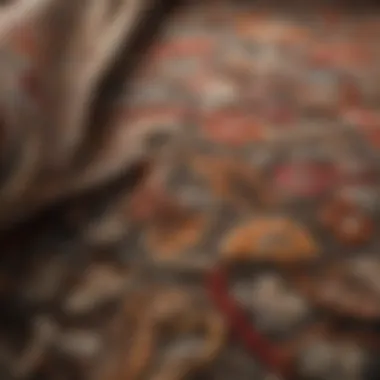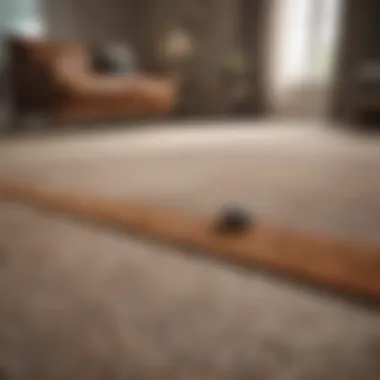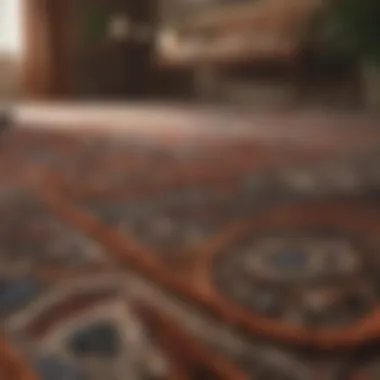Cost Breakdown for Carpet Installation in Two Rooms


Intro
When deciding to install new carpet in two rooms, the journey can get a bit tangled. The process isn't just about picking out a pretty textile; it's a detailed financial commitment that intertwines with your home’s aesthetic and practicality. It’s vital to consider a variety of factors like the type of material, the labor involved, and even the hidden costs that can creep into your budget like an uninvited guest. By understanding these elements, you can make a more informed decision that aligns with both your financial limits and your design goals.
This guide delves into the intricacies of carpet installation costs. We'll examine materials, installation methods, and suggest some budgeting tips that work. Whether you’re sprucing up a living room or cozying up a bedroom, we’ll help you grasp the diverse elements that come into play.
Design Inspiration
Choosing the right carpet is not merely a decision based on functionality; it’s also about finding the perfect fit for your design vision. Design trends continually evolve, making it essential to stay updated on what’s currently hot in the market.
Current Interior Design Trends
Today, many homeowners lean towards modern minimalism. This involves clean lines, neutral colors, and a focus on natural materials—cotton, wool, and jute are climbing high on the popularity ladder. A plush, shaggy carpet can dramatically warm up a room, making it a commonly preferred choice during the chilly months.
Additionally, sustainable options are gaining traction. Eco-friendly carpets, made from recycled materials or natural fibers, appeal to environmentally conscious consumers. These choices not only reflect a commitment to sustainability but can also enhance indoor air quality, which is a boon for health-conscious individuals.
Color Palettes and Their Effects
You might be contemplating which colors lead to which vibes in your space. Shades like soft grays, earthy greens, and sky blues can promote relaxation, while fiery reds and vibrant oranges evoke energy and creativity. Ideally, you should consider the feelings you wish to evoke in each room. For instance:
- Living Room: Cool tones help in fostering a grounded atmosphere.
- Bedroom: Warm neutrals can cultivate coziness and calmness.
When selecting a carpet, it’s worth reflecting on how different shades and textures might transform the overall mood of your space. Toss a few swatches around, and see what vibes best with your existing decor.
"Carpet acts like another layer of paint; it adds depth and character to a room."
In navigating your carpet selection, remember to keep the larger picture in mind; your choices should not only reflect the room itself but also complement the overall flow of your home’s layout.
Additional Considerations
Before you dive headfirst into buying that perfect carpet, spend some time evaluating your budget. Consider what materials give you the best bang for your buck. Sometimes, skipping those flashy brand names can lead you to some hidden gems.
Choosing to work with reputable contractors can also influence your costs significantly. While it may be tempting to hire the fastest local outfit based on price alone, reliability and craftsmanship should not be compromised.
As the carpet installation journey unfolds, understanding these subtleties can make the process smoother and far more satisfying.
Preface to Carpet Costs
When it comes to home improvement, carpeting can be one of the more significant investments you make within your living space. This section will delve into the importance of understanding carpet costs, shedding light on various relevant elements that can significantly impact your budget and satisfaction post-installation.
Carpet installation isn’t just about aesthetics; it’s a blend of practicality, comfort, and value. Following a well-informed approach allows homeowners to savor the long-term benefits of their investment without breaking the bank. By considering factors that influence pricing, such as material choices, installation methods, and room specifications, you’ll be armed with the knowledge necessary to navigate potential pitfalls.
Understanding the Basics of Carpet Pricing
To begin, carpet pricing is more than just a number slapped on a piece of flooring. It can vary widely depending on several key elements. Generally speaking, the price of carpet is determined by its material, quality, brand reputation, and the intricacy of the design. A well-priced carpet might save you money up front, but could lead to higher costs down the line if it wears out quickly or doesn't perform well in your unique environment.
You might find prices ranging from a couple of dollars per square foot to several hundred, specifically for high-end options. This wide range means decisions should be based on your personal needs, existing decor, and lifestyle considerations.
- Material: Wool, nylon, polyester the choices are plentiful, and each has its own pricing structure.
- Quality: Denser carpets generally last longer and can carry a premium sticker.
- Design: Intricately designed carpets, such as those made through elaborate weaving techniques, can also inflate costs for installation.
With so many choices, it’s critical to take an informed approach in examining what works best for you.
Impact of Carpet Quality on Overall Cost
Quality plays a pivotal role when considering the total expenditure on carpeting. Simply put, a higher-quality carpet often equates to a steeper price tag, but it can also translate to enhanced durability and a longer lifespan. Imagine investing in a plush, thick carpet made from natural wool; while it might set you back initially, the enduring comfort might sway your decision, especially in high-traffic areas.


Moreover, quality carpets often come with better warranties and lower maintenance costs, which can save you money in the long run. Here are some insights into quality impact:
- Longevity: High-quality carpets resist wear and tear better than their cheaper counterparts.
- Maintenance: Premium carpets often require less frequent replacement and simpler cleaning routines, saving time and money.
- Comfort: Investing in quality can provide a more luxurious feel underfoot, enhancing your overall home experience.
Factors Affecting Carpet Installation Prices
Understanding the various factors that contribute to the prices of carpet installation is essential for anyone considering a renovation. It’s not just a matter of picking out a carpet and laying it down; several variables can significantly impact the final bill. These factors range from the size and layout of your rooms to the type of materials chosen, the installation method, and even the padding under your carpet. When assessed correctly, these elements can help you budget more effectively and save a few dollars in the long run.
Room Size and Layout Considerations
The size of your rooms plays a crucial role in the overall cost of carpet installation. Larger areas obviously require more carpet, which adds to the material cost. However, it’s not just the square footage; the layout matters too.
For instance, if your room has an odd shape or requires many cuts and seams, that can drive up both the labor and installation costs. Carpeting a rectangular room is far simpler than dealing with an L-shaped or multi-angle area. Therefore, measuring your space accurately and getting an evaluation can save you from any nasty surprises later.
Carpet Material Choices
Choosing the right material is yet another significant factor. Different carpet materials can vary wildly in price, appearance, and durability. Here are two material options to consider:
Wool vs. Synthetic Fibers
Wool carpets tend to be more expensive than synthetic options like nylon or polyester. The key characteristic of wool is its natural fibers, providing exceptional warmth and a plush feel. Wool is also more sustainable as it’s biodegradable, making it popular among eco-conscious consumers.
On the flip side, synthetic fibers offer practical benefits like stain resistance and easier cleaning, making them a common choice for families with children or pets. While wool’s luxurious appeal is undeniable, synthetic options may win when it comes to everyday challenges. Each material comes with its own set of advantages and disadvantages, and understanding these will help you pick what's best for your needs.
Durability and Wear Ratings
Durability is another crucial aspect. Some carpets are designed to withstand heavy foot traffic and last for many years, while others may show signs of wear much sooner. Wear ratings can assist in making this determination. Before you make a decision, check if the carpet has been rated for its ability to resist wear and tear.
Higher-rated options may cost a bit more upfront but could save money in the long haul, as they’ll need replacing less frequently compared to lesser-quality carpets. Knowing the durability of each type of carpet can guide you in picking something that aligns with your lifestyle and budget.
Underlay and Padding Requirements
Don’t overlook the importance of underlay and padding when budgeting for carpet installation. Quality padding can extend the life of your carpet and provide added comfort underfoot. However, cheap options may sacrifice comfort for a lower price. Most installations will require at least some type of padding, so it’s wise to factor this into your overall budget.
Installation Methods and Their Costs
Finally, the method of installation will make a noticeable difference on your cost sheet.
DIY vs. Professional Installation
Some homeowners opt for the DIY route to save cash, and while it might seem like a smart choice, it comes with risks. Errors in installation can lead to expensive corrections later, including sections that buckle or don’t lay flat. Professional installation generally costs more, but the expertise ensures a polished look and longevity that a novice might struggle to achieve. You're paying for skill and peace of mind.
Hidden Costs of Installation
Be prepared for hidden costs that can easily creep into your budget. These might include things like removing the old carpet, disposal fees, or even floor repairs that need to be made prior to the new carpet being laid. Adding an extra cushion of funds for these unforeseen expenses can save you from headaches down the road.
"Understanding these factors can prevent you from overextending your budget and help deliver a satisfying carpet installation experience."
By keeping an eye on all these elements—room size, material choice, installation methods, and hidden costs—you can have more control over your investment while bringing that much-needed warmth to your rooms.
Calculating the Budget for Two Rooms
When it comes to giving your home a facelift, budgeting plays a pivotal role. Properly calculating the budget for installing carpets in two rooms can save you a whole lot of headache down the line. It’s not just about slapping down some flooring; it's about making sure you have funds allocated for every little detail that might pop up along the way.
This section emphasizes not just the preliminary costs involved but also the hidden expenses lurking in the corners. Knowing these costs upfront can be the difference between a successful renovation and a costly misstep. Here, we break down material costs, labor components, and other essential factors that can throw a wrench into your plans if not addressed.


Estimation of Materials and Labor Costs
When estimating costs, it's good to remember that it's often the little things that add up. First off, the type of carpet you choose can drastically impact your overall budget. For instance, plush carpets typically have a higher upfront cost compared to low-pile alternatives.
Moreover, labor costs can vary significantly based on your location and who you hire. Hiring professionals might seem steep, but quality installation can save you money on repairs later. If you opt for DIY, while you might save a penny or two, you'll want to make sure you’re up for the task, as installing carpet is not as straightforward as it appears to be.
- Materials:
- Labor:
- Carpeting itself is where most of the immediate costs lie. Expect to pay anywhere from five to over thirty dollars per square foot, depending on the quality and material.
- Don't forget padding, which can range from fifty cents to two dollars per square foot, crucial for durability and comfort.
- Professional installers might charge between one to three dollars per square foot, excluding materials. Make sure to get quotes from a few pros to find competitive rates.
- If you’re leaning towards DIY, take inventory of tools needed. Renting a carpet kicker or stretcher could cost another fifty to a hundred dollars, depending on rental periods.
Additional Expenses to Consider
When budgeting, you can't just tally visible costs; you also need to account for additional expenses.
Cleaning and Maintenance Supplies
After you put in the effort to install your carpet, keeping it looking brand new is essential. Cleaning and maintenance supplies are often overlooked in initial budgets but are vital for protecting your investment.
A common aspect of cleaning is getting a quality vacuum cleaner. Think about investing in one that specifically caters to carpet fibers as certain models can really deliver the goods. Spot-cleaning solutions are another must-have, as they help tackle those inevitable spills or stains. The beauty of these supplies is that they're not simply a one-off cost, they enhance the lifespan and look of your carpet, thus saving money in the long run.
- Key Characteristic:
- Quality products not only keep your carpet clean but may also come with warranties covering any stains or damages that could arise from normal use.
Removal of Old Carpet
Removing your old carpet can sometimes feel like a hidden hurdle in the budgeting process. Often, homeowners underestimate the effort and costs involved in tearing out existing flooring.
One significant expense here is labor. If you plan to hire a professional, it could run you anywhere from one to four dollars per square foot. If you choose to tackle it yourself, it’s a labor-intensive job that will consume your time and energy. Disposing of the old material is another cost to factor in, especially if your local waste management has specific regulations regarding carpet disposal.
- Unique Feature:
- Removing the old carpet can potentially reveal surprises—like hardwood floors beneath it, which could open up more stylish and cost-effective options in the long run.
Choosing the Right Carpet for Your Space
Choosing the right carpet involves more than just picking a color or pattern. It is about understanding how various elements interact with your lifestyle and the aesthetic goals for your home. The right choice can enhance the functionality of your rooms while amplifying their overall appeal. A carefully selected carpet can create warmth, comfort, and an inviting atmosphere, making it an essential element in interior design. This section dives deep into the aesthetic preferences and practicality considerations, providing insights that align with the unique needs of your space.
Assessing Aesthetic Preferences
Color Schemes and Patterns
The color and pattern of a carpet significantly influence the mood and appearance of a room. Bold hues can energize a space, while softer, neutral tones can create a sense of calm. Consider the overall color scheme of your home when making your choice. Carpets can serve as striking focal points or subtle complements to existing decor.
One key characteristic to think about is how patterns can either conceal or highlight dirt and wear. For instance, a shaggy carpet in a vibrant print may do wonders to hide the inevitable spill from a family gathering, making it a practical choice for high-traffic areas. However, light colors might illuminate a striking design but could also show stains more readily.
- Benefits of Colorful Patterns:
- Disadvantages:
- Can mask imperfections.
- Offer personality and warmth.
- May limit future decor choices.
- Can require more upkeep to maintain cleanliness.
Texture and Feel


The texture of carpet contributes significantly to the comfort and vibe of a room. A plush, soft texture enhances coziness and invites relaxation, perfect for spaces meant for unwinding after a long day. Meanwhile, a low-pile option could be more suitable for rooms where ease of cleaning is paramount, like kitchens or dining areas.
One notable aspect of texture is its ability to affect sound absorption. Thick, heavy carpets can dampen noise, making them ideal in households with energetic children or where work is conducted. Conversely, thinner textures may create a more modern, sleek feel but might come at the cost of acoustic insulation.
- Advantages of Soft Textures:
- Disadvantages:
- Promotes comfort underfoot.
- Appeals to sensory experiences.
- Higher likelihood of showing wear.
- Can trap allergens more easily.
Functionality and Foot Traffic Considerations
Family Activities and Lifestyle
Understanding your family's lifestyle is crucial in selecting the right carpet. If your home is a hub for family activities, you'll want a durable carpet that can withstand daily wear and tear. Heavy foot traffic causes carpets to wear out faster, and finding one that strikes a balance between aesthetics and durability is paramount.
A popular choice for active households includes carpets made from nylon, which boasts impressive resilience against stains and fading, making them a top contender for family rooms or play areas. When selecting a carpet that aligns with your lifestyle, consider not just the visual appeal but also how it will hold up under your dynamic daily routine.
- Benefits of Durable Carpets:
- Disadvantages:
- Long-lasting beauty with wear resistance.
- Safer for kids during playtime.
- Some durable options may lack texture or warmth.
- Higher initial cost may be a concern for some.
Pets and Carpet Durability
When pets roam around, carpets will inevitably face unique challenges. Dogs and cats can be tough on flooring with their claws and occasional accidents. Thus, considering pet-friendly options becomes essential in your decision-making process.
Some carpets are designed specifically for pet owners, utilizing fibers that resist stains and odors. For example, polyester fibers can provide a great balance between appearance and functionality while being less prone to absorbing spills. However, you may trade off some softness for durability, a trade-off to consider based on the nature of your furry friends.
- Advantages of Pet-Friendly Carpets:
- Disadvantages:
- Easier maintenance in regards to spills.
- Resistant against the wear of claws.
- Often may not feel as luxurious to bare feet.
- Some options retain pet hair more than others.
"Choosing the right carpet requires a blend of personal style and practical thinking, ensuring it meets the demands of your lifestyle while enhancing the beauty of your home."
In this way, evaluating the nuances of aesthetic preferences and functionality lays the groundwork for selecting a carpet that not only fits your style but also serves your lifestyle needs effectively.
Final Thoughts on Carpet Installation Costs
Understanding the costs involved in carpet installation is crucial for anyone considering a home renovation. It’s not just about looking for the cheapest options; it��’s about ensuring you invest wisely, balancing quality and price. The end result should align with your personal style while also providing comfort and practicality underfoot.
Budgeting wisely is more than simply slapping a number on a paper and imagining that’ll cover it all. It involves digging deep into every aspect from materials to tools and maintenance. Keep in mind that unforeseen expenses are part of the game. Laying carpet in two rooms? You don’t just buy a roll of carpet and be done with it. Think about underlayment, which can enhance both comfort and longevity, often used with specific materials. Then there’s labor. Whether you roll up your sleeves or call on professionals to handle the grunt work, the cost can vary widely.
Budgeting Wisely for Your Renovation
Crafting a budget is akin to building a roadmap. Without one, it's easy to go off-track, leading to potential overspending. Here are key points to consider:
- Calculate the square footage: Measure your rooms accurately. Add a bit extra for waste, typically about 5-10% of your total needed carpet.
- Choose your materials wisely: Look at long-term costs. Wool carpets might be pricier upfront but may offer durability that synthetic options don't, ultimately saving you cash in maintenance and replacement.
- Factor in installation: Whether you're going DIY or hiring pros, always ask for quotes. Some installers include the costs of materials and underlay in their pricing, while others may have separate fees.
- Budge for accessories: Things like transition strips, padding, and tools may not be top of mind during planning, but they add to your price tag.
- Anticipate maintenance costs: Certain carpets will require cleaning more often than others. This should be factored into your ongoing budget.
In short, having a well-defined financial plan promotes better decision-making and helps sidestep last-minute surprises that could break the bank.
When to Seek Professional Advice
Deciding whether to go solo on installation or hire experts can hinge on your level of confidence and experience. If accommodating everything seems like a mountain to climb and you find yourself second-guessing or feeling overwhelmed, seeking professional guidance may be your best bet. Here are signs it might be time to ring in the pros:
- Complex layouts: If your space involves lots of nooks and crannies, possibly with multiple angles, getting a professional involved could save you a headache and ensure a perfect fit.
- Specialized materials: Some carpets require specific installation techniques that demand expertise to avoid costly mistakes. If you’ve chosen a luxury fiber or intricate design, don’t risk going it alone.
- Preparation worries: Installation often involves more than just laying down carpet. If removal of old flooring or extensive prepping of the subfloor is needed, hiring seasoned hands can pay off.
- Lack of tools: Proper tools make a world of difference. If you’re not equipped, the investment in tools might outweigh paying someone who has them.
Always remember: There's no shame in asking for help. Investing in professional services can offer peace of mind, ensuring the job is done right—not just done.
meets your practical needs, and stands the test of time. Your home's interior deserves no less.















